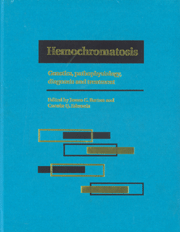Book contents
- Frontmatter
- Contents
- List of contributors
- Foreword
- Part I Introduction to hemochromatosis
- Part II Genetics of hemochromatosis
- Part III Metal absorption and metabolism in hemochromatosis
- Part IV Diagnostic techniques for iron overload
- Part V Complications of iron overload
- Part VI Therapy of hemochromatosis and iron overload
- Part VII Infections and immunity in hemochromatosis
- Part VIII Hemochromatosis heterozygotes
- Part IX Relationship of hemochromatosis to other disorders
- Part X Animal models of hemochromatosis and iron overload
- Part XI Screening for hemochromatosis
- Part XII Hemochromatosis: societal and ethical issues
- 52 Hemochromatosis: effect of iron fortification of foods
- 53 Evidence for population-based testing for hemochromatosis
- 54 Ethical issues and hemochromatosis
- 55 Hemochromatosis patients as blood and tissue donors
- 56 Genetic counseling for hemochromatosis
- Part XIII Final issues
- Index
52 - Hemochromatosis: effect of iron fortification of foods
from Part XII - Hemochromatosis: societal and ethical issues
Published online by Cambridge University Press: 05 August 2011
- Frontmatter
- Contents
- List of contributors
- Foreword
- Part I Introduction to hemochromatosis
- Part II Genetics of hemochromatosis
- Part III Metal absorption and metabolism in hemochromatosis
- Part IV Diagnostic techniques for iron overload
- Part V Complications of iron overload
- Part VI Therapy of hemochromatosis and iron overload
- Part VII Infections and immunity in hemochromatosis
- Part VIII Hemochromatosis heterozygotes
- Part IX Relationship of hemochromatosis to other disorders
- Part X Animal models of hemochromatosis and iron overload
- Part XI Screening for hemochromatosis
- Part XII Hemochromatosis: societal and ethical issues
- 52 Hemochromatosis: effect of iron fortification of foods
- 53 Evidence for population-based testing for hemochromatosis
- 54 Ethical issues and hemochromatosis
- 55 Hemochromatosis patients as blood and tissue donors
- 56 Genetic counseling for hemochromatosis
- Part XIII Final issues
- Index
Summary
Introduction
It has been estimated that more than one billion inhabitants of the world are anemic and that the predominant cause is iron deficiency. The prevalence of anemia varies among different geographic regions from less than 10% to more than 50%, depending mainly on the socioeconomic status of the population. The prevalence also varies greatly within a population and is much higher with the increased physiological iron requirements associated with growth, menstruation, and childbearing. The term ‘nutritional’ has been applied to the iron deficiency identified in population surveys on the assumption that the predominant cause is inadequate iron absorption due to the low bioavailability of dietary iron.
In recent years there has been an effort to define the liabilities associated with iron deficiency more precisely and thereby assess the cost-effectiveness of various intervention strategies. The most important deficit is the impairment in cognitive performance in infants and toddlers who develop iron-deficiency anemia. Even a brief period of iron deficiency in persons less than two years of age can lead to lasting deficits in mental and physical performance. Another significant liability is the limitation in work output in adults who become iron deficient. Studies in manual workers whose work output can be measured accurately have indicated that the repair of iron-deficiency anemia can lead to a significant increase in work productivity. Finally, there is evidence that iron-deficiency anemia during pregnancy is associated with low birth weight and preterm delivery, although the need for routine iron supplementation during pregnancy is still debated. However, these liabilities have only been demonstrated when iron deficiency is severe enough to produce anemia.
- Type
- Chapter
- Information
- HemochromatosisGenetics, Pathophysiology, Diagnosis and Treatment, pp. 535 - 543Publisher: Cambridge University PressPrint publication year: 2000
- 4
- Cited by



